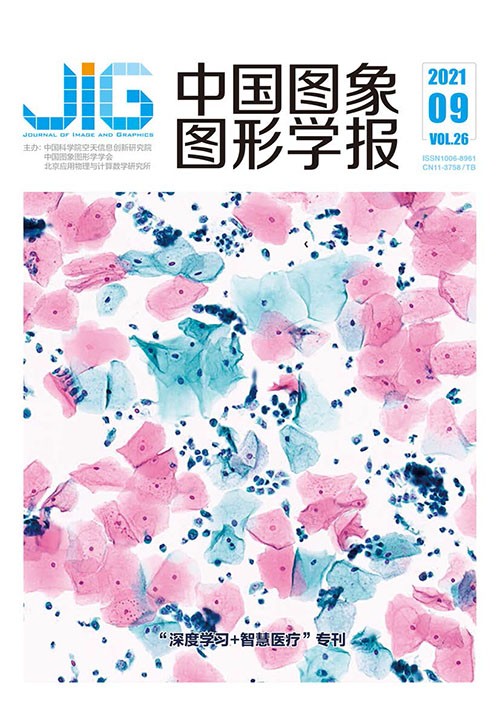
LFSCA-UNet:基于空间与通道注意力机制的肝纤维化区域分割网络
陈弘扬1, 高敬阳1, 赵地2, 吴忌3, 陈金军4, 全显跃5, 李欣明5, 薛峰3, 周沐瑶5, 柏冰冰5(1.北京化工大学信息科学与技术学院, 北京 100029;2.中国科学院计算技术研究所, 北京 100080;3.上海交通大学医学院附属仁济医院肝脏外科, 上海 200025;4.南方医科大学南方医院感染内科, 广州 510515;5.南方医科大学珠江医院影像诊断科, 广州 510282) 摘 要
目的 肝纤维化是众多慢性肝脏疾病的常见表现,如不及时治疗可发展为肝硬化甚至引发肝癌。肝纤维化的准确评估对临床治疗和预后评估等至关重要。目前,肝纤维化的诊断通过肝穿活检判断,有创且有并发症危险。为此,基于影像学的无创诊断方法越来越受到关注。本文提出一种基于通道注意力与空间注意力机制改进的用于肝纤维化区域的自动化分割U-Net (liver fibrosis region segmentation network based on spatial and channel attention mechanisms,LFSCA-UNet)。方法 依据Attention U-Net的改进方式,围绕U-Net的跳跃连接结构进行基于注意力的改进,在AG (attention gate)的基础上,加入以ECA (efficient channel attention)模块为实现方式的通道注意力机制,依据加入ECA的位置,LFSCA-UNet分为A、B、C共3个子型。结果 在肝数据集上与其他实验网络进行评估对比,本文提出的LFSCA-UNet网络结构平均Dice系数达到了93.33%,相比原始U-Net的Dice系数提高了0.539 6%。结论 本文方法将空间注意力机制与通道注意力机制进行结合,有效提高了肝纤维化区域的分割精度,对空间注意力模块使用通道注意力模块优化输入和输出,增加了网络的稳定性,提升了网络的整体效果。
关键词
LFSCA-UNet: liver fibrosis region segmentation network based on spatial and channel attention mechanisms
Chen Hongyang1, Gao Jingyang1, Zhao Di2, Wu Ji3, Chen Jinjun4, Quan Xianyue5, Li Xinming5, Xue Feng3, Zhou Muyao5, Bai Bingbing5(1.College of Information Science and Technology, Beijing University of Chemical Technology, Beijing 100029, China;2.Institute of Computing Technology, Chinese Academy of Sciences, Beijing 100080, China;3.Department of Liver Surgery, Renji Hospital, Shanghai Jiao Tong University School of Medicine, Shanghai 200025, China;4.Department of Infection, Nanfang Hospital, Southern Medical University, Guangzhou 510515, China;5.Department of Radiology, Zhujiang Hospital, Southern Medical University, Guangzhou 510282, China) Abstract
Objective Liver fibrosis is a common manifestation of many chronic liver diseases. It can develop into cirrhosis and even lead to liver cancer if not treated in time. The early diagnosis of liver fibrosis helps prevent the occurrence of severe liver disease. Studies have shown that timely and correct treatment can reverse liver fibrosis and even cirrhosis. Therefore, the accurate assessment of liver fibrosis is essential to the clinical treatment and prognosis assessment of liver fibrosis. At present, the diagnosis of liver fibrosis in the medical field is evaluated through liver biopsy, which is generally a safe procedure but invasive. The complications of liver biopsy are rare but potentially lethal, so noninvasive diagnosis methods based on imaging have attracted considerable interest. Method This paper proposes a network for the segmentation of liver fibrosis regions, called LFSCA-UNet(liver fibrosis region segmentation network based on spatial and channel attention mechanisms-UNet). It has improved the U-Net with two different attention mechanisms. U-Net is a convolutional neural network used for image semantic segmentation. Attention U-Net is an improved version of U-Net, it adds a group of attention gate modules into each skip connection of the original U-Net. The attention gate modules in attention U-Net is a spatial attention mechanism. LFSCA-UNet adds a channel attention mechanism to each skip connection structure. In this study, the efficient channel attention(ECA), which is a channel attention mechanism based on the squeeze and excitation network, was used in implementing the added mechanism. The core idea of the squeeze and excitation network is to allow networks to automatically learn dependencies between channels. This network changes a conventional convolution layer to a convolution layer with a squeeze and excitation block, which can be divided into two parts:squeeze and excitation. The squeezing part uses global pooling to obtain a feature vector of a current convolutional layer feature map, whereas the excitation part uses two fully connected layers with different numbers. The first drop of the dimension and the second upgraded, and finally, the weight of each channel is obtained after sigmoid activation, which is multiplied by the original feature map as the input of the subsequent layer of the network. The efficient channel attention block is an improvement of the squeeze and excitation block, which removes the part of reducing dimension and uses 1 d convolution instead of the fully connected layer. It has better performance and fewer parameters. The CT(computed tomography) images used in this study was obtained from 88 patients with liver fibrosis and provided by the Department of Liver Surgery, Renji Hospital, Shanghai Jiao Tong University School of Medicine. One Nvidia Tesla P100 graphics cards with 16 GB memory were used in training networks, and Python 3.8.5 and PyTorch 1.7.1 were used. Result This paper horizontally compared five different experimental networks according to five different indicators, namely, Dice coefficient, Jaccard index, precision, recall (sensitivity), and specificity. LFSCA-UNet gets the highest result of mean Dice coefficient (0.933 3), better than the original U-Net (0.539 6%). Conclusion This paper verifies that the combination of spatial attention and channel attention mechanisms can effectively improve the segmentation result of liver fibrosis. For the spatial attention module, using the channel attention module in optimizing inputs can increase network stability and optimizing outputs can improve the overall effect of the network.
Keywords
|



 中国图象图形学报 │ 京ICP备05080539号-4 │ 本系统由
中国图象图形学报 │ 京ICP备05080539号-4 │ 本系统由